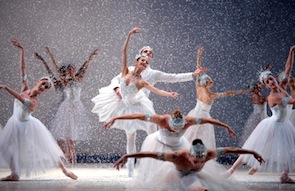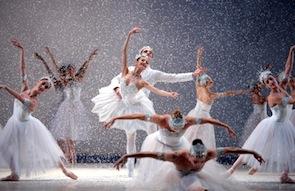
Photo by Erik Tomasson
Say this about Helgi Tomasson: He understands little girls. For proof, look at his Nutcracker, which opened Friday night at the War Memorial Opera House. It goes straight to a little girl’s dreams of visiting faraway places, having big adventures and meeting, yes, a handsome prince. But better than that, bravely rescuing a handsome prince, and being rewarded by being turned into a beautiful princess who dances with him. To Tchaikovsky!
This story’s about a girl named Clara Stahlbaum living in San Francisco in 1915. She’s a child on the verge of womanhood. We can tell, because at her family’s Christmas party Clara (Nicole Finken) dances a reel with the grownups as her friends watch from childhood’s sidelines.
Clara’s also probably a member of the one percent. We can tell because her street, filled with lovely Victorians, is monitored by a cop who hassles two youths delivering a Christmas tree, and a poor flower seller hawks her wares. We can also tell because the Stahlbaums’ Christmas tree, in the middle of their luxurious parlor, is decorated with electric lights for the first time (that’s what the souvenir program book says), and covered in golden ornaments. Clara seems like a lovely young person, and her family’s swell, except for her brat of a brother (Nicolas Dolce), who plays a toy drum and breaks her Nutcracker. He will grow up to be a robber baron, for sure.
The coolest member of the family, it goes without saying, is the toymaker Uncle Drosselmeyer (Val Caniparoli), who embodies a hippie vibe that’s just part of the local magic — it goes with the nutcracker he gives to Clara. Drosselmeyer wears a red embroidered satin cloak over his blue workshirt and pants, has bushy white hair and an eyepatch. He feels extremely real. That’s part of the gift of this Nutcracker, which premiered in 2004.
San Francisco Ballet Artistic Director Tomasson chose an era and found amazing designers to help us be part of it. Michael Yeargan did the scenery, Martin Pakledinaz the costumes, James F. Ingalls the lighting, and Wendall K. Harrington the projections, which include wonderfully specific old photos. As the show begins, we are transported to the misty Farallons, a hint of the otherworldliness to come. We see horse-drawn streetcars, the 1915 Pan Pacific Exposition buildings, the roofline of the Crystal Palace in Golden Gate Park. This realism makes the fantasy even better. And the conducting, by Martin West, pulled the whole thing together. The orchestra was fine.
And the audience sits enthralled. Little girls (yes, there are a few boys, and they seem delighted as well) in their very nicest clothes (my favorite was the child whose shiny red shoes matched her red Minnie Mouse pocketbook) dance through the lobby, trying out twirls, leaps and slides, until it’s time to sit down and watch. When they do, they’re rapt, with a few exceptions. Memo to the mother whose little girl’s voice is louder than the celesta: give her (and us) a couple of years.
The company and the San Francisco Ballet School students — from little to almost grown — are superb. More than that, they’re a delight.
The Nutcracker Prince, Gennadi Nedvigin, was a gallant escort for Clara and gave a clearly mimed account (in other productions, a child does this, and it’s often not very successful) of how she rescued him after his battle with the Mouse King (Daniel Deivison, who was terrific as he vanished headfirst through a trap door). In the grand pas de deux with the dynamic Maria Kochetkova, Nedvigin stumbled once as he shot through a series of enormous leaps and beating jumps, but recovered nicely. Kochetkova’s footwork, especially the tiny beats at the ankle, is dazzlingly precise, and she finished in a whirl of fouettes. The King and Queen of the Snow, Davit Karapetyan and Vanessa Zahorian, gave Clara and the Prince a gracious welcome and the audience a generous, warm performance. The snow scene, incidentally, takes the prize among all remembered Nutcrackers for density of snow and beauty of surroundings, and the corps of Snowflakes was the embodiment of grace and unity. The first act ends with Clara and the Prince climbing on board an enchanted coach drawn by horses – dancers with glass-like masks—to go off to see the Sugar Plum Fairy in the Crystal Palace. It’s a moment of the tenderest fantasy, a young girl, surrounded by beauty, going forward into the unknown. Ballerinas, princes, horses — and Christmas. What more could any little girl want?
As the Sugar Plum Fairy greeting Clara and the Prince, Frances Chung was delicately graceful, an enchanted creature. At times she seemed hesitant. But when she warmed to her kingdom and its subjects, the dragonflies, butterflies and ladybugs, she became strong and confident, most notably in a fine flurry of turns and space-eating leaps.
As for the secondary roles, Clara Blanco’s mechanical doll got the first burst of applause because she was the first certifiable ballerina … she danced on her toes. She was sharp and charming. Lonnie Weeks in his high-flying Chinese dance stole the show from the wonderfully undulating six-student red Chinese dragon. The Russian variation — a troika, of course — consisted of Pascal Molat, Daniel Baker and Benjamin Stewart bursting out of gigantic Fabergé eggs and doing all the things you want guys in peasant shirts and high boots to do, squatting and jumping and rising and falling and kicking and then doing it again, even lower, even higher.
Madam Du Cirque (Louis Schilling) manipulated her gigantic red-and-white tent-skirt with vigor and the bear within (Matthew Stewart) was almost as dear as the little Buffoons, wee tykes in polka-dot costumes just starting to learn ballet. You can see why little girls (and their mothers) love this. Not only could you rescue a prince, but you might become a dancer. Goodness knows it’s happened before.

